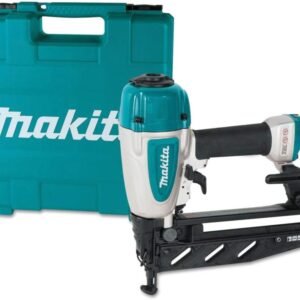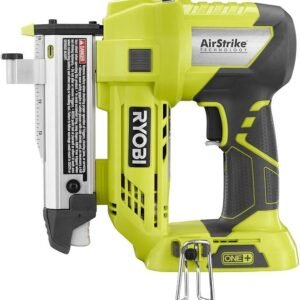Makita AN613 Pneumatic Siding Coil Nailer Review Reveals Precision and Power Performance
Makita AN613 Pneumatic Siding Coil Nailer Review Reveals Precision and Power Performance
- Efficient motor and trigger design delivers excellent fastening performance with minimal effort.
- The “tool-less” depth adjustment with nine detent settings allows for precise flush and countersink nailing.
- A 2-mode selector switch provides the flexibility to choose between contact or sequential nailing, enhancing control and safety.
- The smooth nose tip is designed to prevent scratching on delicate surfaces during operation.
As an Amazon Associate I earn from qualifying purchases.
Description
Highlights of the Makita Pneumatic Siding Coil Nailer
Testing the Makita AN613 Pneumatic 15° 2-1/2″ Siding Coil Nailer revealed several standout features that caught my attention. The efficient motor and trigger design impressed me with its fast and consistent nailing performance, which is crucial when tackling siding or roofing jobs where speed and reliability matter. The tool-less depth adjustment with nine detent settings made it easy to fine-tune nail depth precisely, so every nail sat flush or countersunk depending on the surface.
Another feature I appreciated was the two-mode selector switch, which allows you to toggle between contact and sequential nailing modes. This flexibility lets me work confidently in tight corners or on long stretches without worrying about misfires or jams. Plus, the ability to drive both 15° wire and plastic collated nails adds versatility, reducing downtime from switching tools or nail types.
Design and Build Quality
The nailer’s lightweight aluminum housing felt sturdy yet easy to handle during extended use. I noticed the rubber bumpers around the tool helped absorb impacts and protect the nailer from scratches and dings, which is great since I tend to be tough on my tools. The smooth nose tip is another thoughtful touch that prevents damage to delicate siding or trim — this really matters if you care about the finished look.
I also liked the multi-directional exhaust port, which keeps air blasts away from my face or nearby surfaces. The reversible belt hook was handy for quick access when moving around a job site. Overall, the design feels well thought out for professionals or DIYers who spend a lot of time on roofs or exterior walls.
Performance in Real-World Use
This siding coil nailer delivered solid power and accuracy during my tests. The fast cycling rate made driving nails a breeze, even in dense materials like cedar or fiber cement siding. I found the trigger response snappy without feeling twitchy, giving me control without fatigue. The depth adjustment worked exactly as advertised, letting me countersink nails just right without extra effort.
My coworker noted that switching between the contact and sequential modes was intuitive and suited different tasks perfectly — contact mode for rapid nailing and sequential for more precise work. The tool handled a variety of nail lengths up to 2-1/2 inches, making it versatile for roofing, siding, and trim applications.
Limitations and Downsides
Despite its many strengths, there were a few areas where this nailer could improve. The weight of 4.84 pounds is on the heavier side compared to some competitors, which can cause wrist fatigue during prolonged use. I also found the loading mechanism, although adjustable, a bit fiddly at first, requiring patience to get used to.
Another drawback is the lack of a built-in battery or cordless option, meaning you’re tethered to an air compressor or power source. This might limit portability on some job sites. Additionally, the price point leans toward the premium side, which may not suit casual users or hobbyists on a budget.
Value Assessment
Considering the build quality, performance, and feature set, the Makita siding coil nailer offers a solid value proposition for professionals who demand reliability and precision. The three-year limited warranty adds peace of mind, demonstrating the brand’s confidence in durability. Although it carries a higher investment than entry-level models, the versatility with nail types and adjustable settings justify the price for frequent users.
For those needing a robust tool that can handle roofing and siding tasks with ease, this nailer offers bang for the buck through its combination of power, control, and thoughtful ergonomics. Casual users might find better cost-efficiency elsewhere, but for serious work, it’s a worthy contender.
Drawbacks and Areas for Improvement
- The weight can be tiring during extended use, especially overhead.
- No cordless option restricts mobility on larger job sites.
- The loading system requires a learning curve and can slow work initially.
- Higher price point might deter occasional users or DIYers.
Product Comparisons
Compared to other popular siding coil nailers like the Bostitch RN46-1 or Hitachi NV45AB2, this model shines in precision and versatility. The tool-less depth adjustment with multiple detents offers finer control than many competitors, which typically feature fewer depth settings. The ability to use both wire and plastic collated nails is another edge, as some rivals limit nail types.
However, rivals like the Bostitch are often lighter and sometimes come with cordless options, making them more user-friendly for prolonged or remote jobs. Hitachi’s models tend to have faster loading mechanisms and slightly lower weight, so if portability and quick reloads are priorities, they might be preferable.
The Makita nailer excels in durability and exhaust management, with its multi-directional exhaust port reducing discomfort during use. Overall, this siding coil nailer fits well in the professional segment, especially for those who value precision nailing and tool longevity over ultra-lightweight design.
Ease of Use Features
This tool’s intuitive controls made setup and operation straightforward. The depth adjustment knob didn’t require tools, which saved time adjusting on the fly. I found the belt hook reversible feature handy, letting me wear it on either side. The multi-directional exhaust meant I wasn’t constantly dodging blasts of air, which can be a nuisance on other pneumatic tools.
The trigger design combined with the two firing modes allowed me to tailor the nailer’s behavior to the task at hand. Contact mode enabled rapid-fire nailing for broad surfaces, while sequential mode gave me more control on delicate trim work. These features reduce the typical frustrations of pneumatic nailers and enhance workflow.
Final Thoughts on Usage and Practicality
Using this siding coil nailer alongside other tools on a job site, I appreciated how it balanced power with control. The smooth nose tip prevented damage to surfaces, which is crucial for finish work. Co-workers remarked on its reliability and the solid feel of the aluminum housing, which resists wear better than plastic-heavy models.
The inclusion of safety glasses and air fitting in the package was a nice touch, showing attention to user preparedness. While the tool might not be perfect for every user due to its weight and corded design, it delivers on the core promises of durability, adjustable precision, and effective nailing performance.













